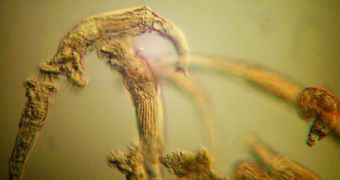Sex is considered the engine of the evolution. Without sex, we would all be similar clones. Sex brings diversity, but also it can repair the effects of negative mutations. Healthy genes from one parent can counteract the presence of a damaged (mutated) gene from the other parent, resulting healthier offspring.
Thus, theoretically, asexual species should accumulate harmful mutations over time, that would doom the species. But some microscopical "worms" called bdelloids, from the group of rotifers, challenge this: they have renounced sex for tens of millions of years. Their secret has been revealed by a new research published in the journal "Proceedings of the National Academy of Sciences": a powerful method to repair mutations.
Today, only about 2,000 of 2 million known species reproduce in a completely asexual way, without any fertilization of an egg by sperm being involved. And bdelloids have proved to be extremely prolific: these water invertebrates evolved into over 400 species.
To check the DNA repair mechanisms of the bdelloids, the researchers exposed the tiny worms to gamma rays, which cut into pieces the DNA molecules. Bdelloids kept on multiplying at gamma radiation levels five times over the maximum level tolerated by all the other animal species.
"We kept exposing them to more and more radiation, and they didn't die and they didn't die and they didn't die," said researcher David Mark Welch, an evolutionary biologist at the Marine Biological Laboratory at Woods Hole, Massachusetts.
These powerful DNA repair mechanisms did not evolve in order to resist such high radiation levels, not naturally encountered on Earth, but to stand extreme water loss, which can destroy their DNA at the same level. These creatures inhabit temporary pools and can experience complete desiccation at any moment.
The team discovered proof that bdelloids, like most animal species, had originally possessed two copies of each chromosome. But, at a given moment, the whole genome of the ancestral bdelloid got duplicated, resulting in an animal with four copies of each chromosome (a condition called tetraploidy, opposed to diploidy in most animals, humans included). This animal had four genes for each function.
The bdelloids preserved most of their extra genes, and "we believe they have kept most of their duplicate genes because they are serving as templates for DNA repair," Welch said.
DNA damage is a main factor in cancer, aging, inflammation and other diseases, and "being able to understand how animal cells can be so resistant to radiation may be of some interest in understanding how these conditions might be inhibited in human cells," Matthew Meselson, a molecular geneticist at Harvard University, told LiveScience.

 14 DAY TRIAL //
14 DAY TRIAL //